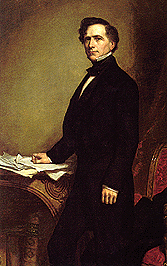Indian Policies
 Soon after the railroad survey expeditions were ordered into the field, the government
authorized a number of curiously related actions. In August 1853, the President of the
United States, Franklin Pierce, ordered the Commissioner
of Indian Affairs, George W. Manypenny, "to visit the Indian country to confer with the various
tribes, as a preliminary measure, looking to negotiation with them for the purpose of procuring
their assent to a territorial government and the extinguishment of their title, in whole or in
part, to the lands owned by them[23]".
Soon after the railroad survey expeditions were ordered into the field, the government
authorized a number of curiously related actions. In August 1853, the President of the
United States, Franklin Pierce, ordered the Commissioner
of Indian Affairs, George W. Manypenny, "to visit the Indian country to confer with the various
tribes, as a preliminary measure, looking to negotiation with them for the purpose of procuring
their assent to a territorial government and the extinguishment of their title, in whole or in
part, to the lands owned by them[23]".
Manypenny did not visit the tribes of the far Southwest or the Northwest; he went nowhere near the region favored for transcontinental railroad routes by partisans of the South or North. Instead, he visited the Omaha, Oto, and Missouri, the Sauk and Fox, the Kickapoo, Delaware, and Shawnee - mostly tribes that just a few years earlier had been driven across the Mississippi to new lands that they had been promised were theirs "as long as the grass shall grow or the waters run[24]". With these tribes Commissioner Manypenny made treaties from 1854 to 1857, taking from the Indians vast areas of land for the government of the United States.
